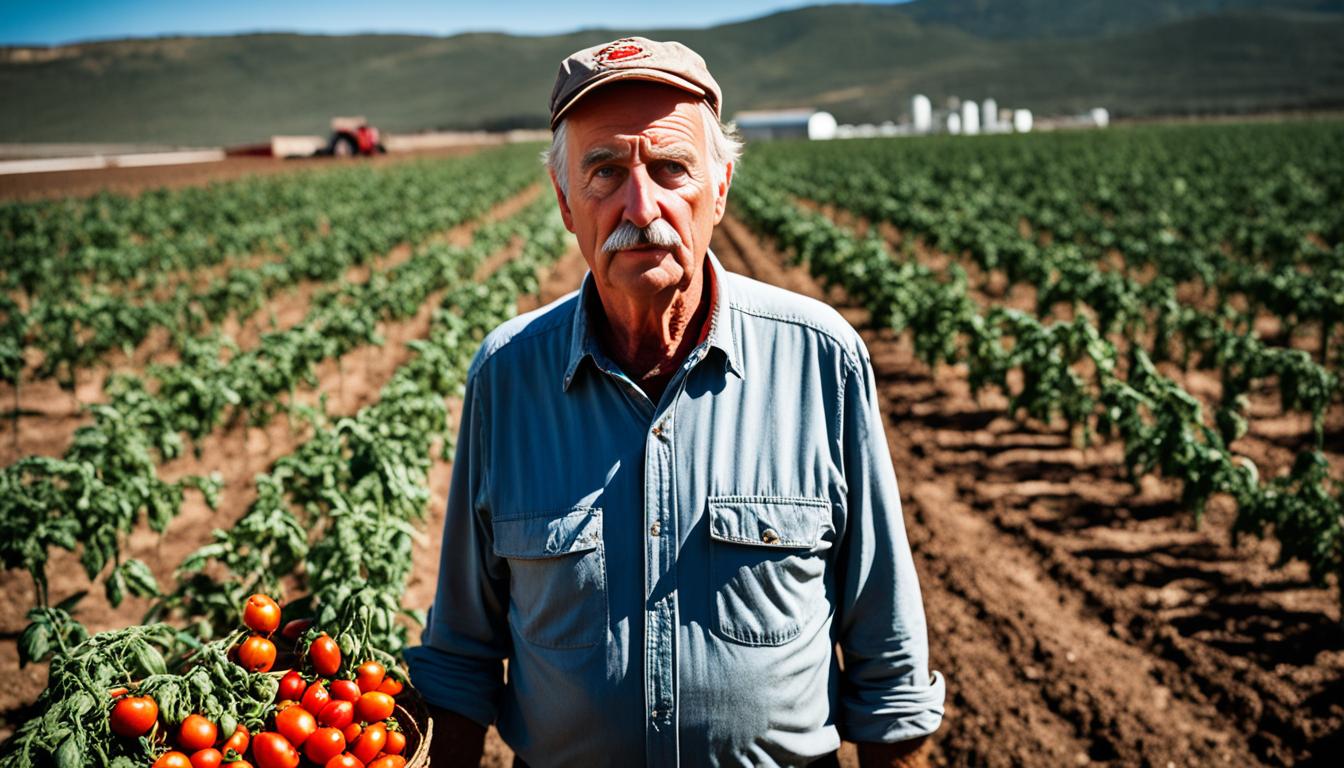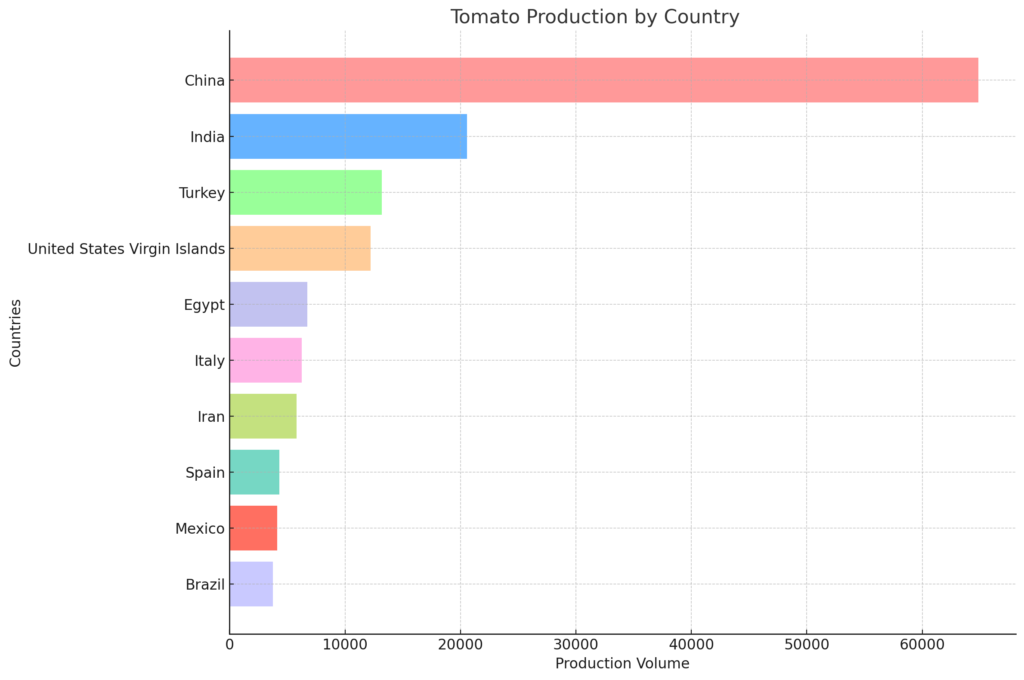Being a tomato farmer, I often wonder about the real economic issues we face now.
Our industry spans the globe, facing various challenges and chances. Tomato prices in the Netherlands and Belgium have been higher than usual, even hitting record levels recently.
Yet, the UK’s energy prices have soared, causing growers there to lose money.
To cope, many have reduced the number of crops they plant. In Italy, prices slightly dropped but stayed high. This happened as more regions started competing for different kinds of tomatoes.
Key Takeaways
- Tomato farmers face a mix of tough economic challenges, such as changing prices and input costs.
- There are big issues with moving tomatoes, like poor roads and not enough transport.
- Dealing with pests and diseases costs a lot, which makes it harder for tomato farmers.
- Changes in the climate and new rules are making water and land harder to get, making things tougher.
- Innovation and research are key for tomato growers to do well in a changing market.
Volatile Pricing and Market Fluctuations
The tomato market in Mexico changes a lot, making it hard for farmers to know what to expect. With prices going up and down, also the weather can be very up in the air. When the weather is good, there’s too many tomatoes which makes the prices drop. This can mean farmers might not make enough money to cover their costs. If farmers can, they sell their tomatoes to other countries where they can get more money.
Price Volatility and Market Competition
Mexico makes a lot of money exporting tomatoes, about $1,980 million. This makes tomatoes the fourth most important product Mexico sells around the world. But, the U.S. has been buying more tomatoes from Mexico, making things hard for U.S. farmers. In 2020, the U.S. grew fewer tomatoes than before, just about a third of what it did in 2000. If the U.S. buys even more from Mexico, U.S. farmers, especially in Florida, could lose a lot of money.
With all these changes, how Mexico sells tomatoes to the U.S. is important. It takes work to stay ahead and deal with financial challenges. Yet, the market for tomatoes seems big both at home and overseas. Mexican and U.S. tomato farmers need to figure out how to handle the ups and downs in prices and the competition. They want to make sure their farms will be okay for a long time.
| Production Method | Percentage of Total | Yield (t/ha) |
|---|---|---|
| Greenhouses | 40.0% | 184.9 |
| Open Fields | 32.8% | 37.3 |
| Shade Cloths | 26.4% | N/A |
| Polytunnels | 0.8% | N/A |
About 40.0% of the tomatoes in Mexico are grown in greenhouses. Greenhouses can make a lot more tomatoes than open fields, almost five times more. This shows that using more modern ways to grow can help make even more tomatoes.
The most tomato-growing happens in certain areas of Mexico like Sinaloa and San Luis Potosí. However, the best tomato farming is in places like Querétaro, Nuevo León, and Coahuila. These areas can teach us a lot about how to do better with tomatoes and make things more fair across different places.
“The tomato market in Mexico is full of changes, which makes it hard for farmers to plan. This is because prices and weather are always shifting.”
Tomato Production By Country 2024
Tomatoes are one of the most popular foods worldwide. While many people think of tomatoes as vegetables because of their taste, they are actually fruits because they contain seeds. Tomatoes are used in a variety of dishes, from ketchup and pasta sauce to salads and garnishes. Due to their versatility, the demand for tomatoes is very high, with certain countries leading in production.
China is the top producer of tomatoes globally. In 2017, China produced around 60 million tons of tomatoes, more than double the amount produced by the second-leading country, India, which produced about 20 million tons in the same year.
Here is a list of tomato production by country in 2020:
|
Country
|
Tomato Production 2020
|
|---|---|
| China | 64,866 |
| India | 20,573 |
| Turkey | 13,204 |
| United States Virgin Islands | 12,227 |
| Egypt | 6,731 |
| Italy | 6,248 |
| Iran | 5,787 |
| Spain | 4,313 |
| Mexico | 4,137 |
| Brazil | 3,754 |
Rising Input Costs and Access to Credit
Tomato farming faces a big problem: higher costs for everything. In Pakistan, the cost per hectare for tomato farming is very high. This includes things like land tax and rent. The labor cost is also high, making it expensive to grow tomatoes. These costs make it hard for farmers to make money from selling their tomatoes.
This challenge is not just in Pakistan but worldwide. In the U.S., small family farms work on almost half of the land but earn very little money. In South Africa, farmers find it tough to earn enough money, forcing many to live in poverty. Their low incomes make it hard to improve their farms and earn more.
Getting loans at fair rates is hard for tomato farmers. In Florida, small farmers struggle to meet regulations and get loans to help them. In the U.K, a workshop to talk about these problems has been helpful.
Fixing the cost and credit problems is key for tomato farmers. They need support to get through these tough times. Ways to help include using farming methods that can withstand climate changes and loans for new, stronger tomato plants. By solving these issues, we can make sure tomato farmers have a better and more profitable future.
Transportation and Storage Challenges
Tomato farmers in the United States have big obstacles with moving and storing their crops. The lack of good farm infrastructure, especially in rural places, slows down the movement and saving of tomatoes.
Inadequate Infrastructure and Logistics
The key issue is the not-so-great transport system. Places in the U.S. where tomatoes are grown might not have good roads. This makes it hard for farmers to get their produce to where it needs to go quickly and cheaply. For small farmers, it can be very expensive to get their tomatoes to central points. They might have to pay a lot for someone to carry the tomatoes, like on a motorcycle.
Also, where tomatoes are kept is often not good enough. This causes a lot of tomatoes to go bad after they are harvested. Some parts of the U.S. see up to 39.3% of tomatoes going to waste from the time they are picked to when they are bought. This waste is bad not just for farmers’ money but also for how much food is available and used safely.
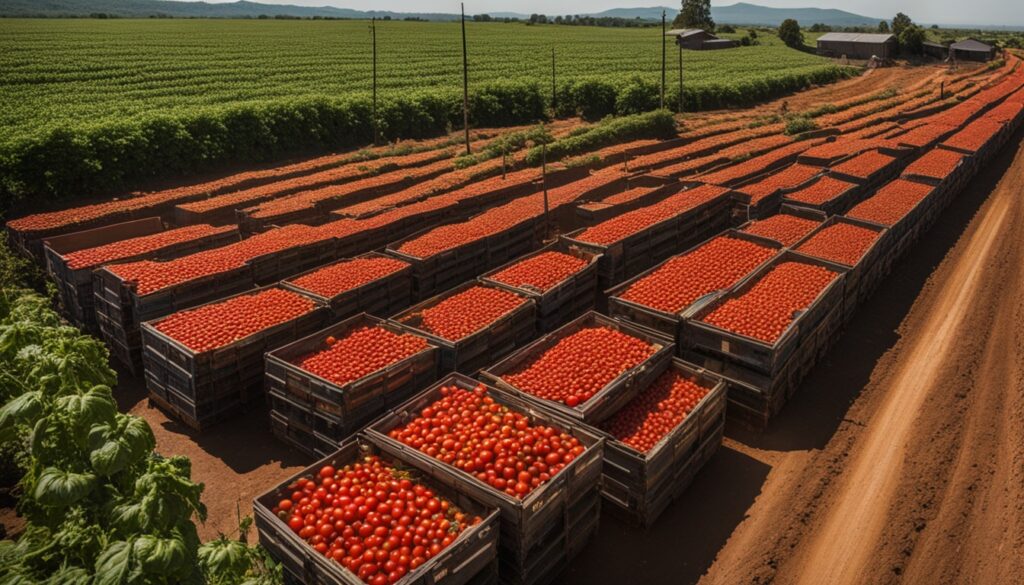
To make things better for tomato farmers, we need to fix how things are transported and stored. We should invest in making rural roads better and easier for farmers to use. This could mean less money spent and faster trips to where tomatoes are processed or sold. Also, using new ways to save tomatoes after they are picked and improving places where they are stored could lower how much is wasted.
“Anything being imported from the EU has had the benefit of EU subsidies, US growers don’t get these, they didn’t get them before either as most of the growers are too small and there was too much paperwork involved,” according to an industry source.
If we solve these big problems with moving and storing tomatoes, farmers in the U.S. can do better. They could earn more and help make sure our food system is strong.
Pest and Disease Management Costs
Tomato farmers face big economic issues, like high pest control costs. In Mississippi in 2012, 546 farms grew tomatoes on 339 acres. Another 83 farms used greenhouses on 6.05 acres. This shows most of Mississippi’s tomatoes grow in the open, which needs a lot of pest watch.
On average, each farm grows tomatoes on 0.57 acres, with many small ones. About 40.4% of vegetable farms in Mississippi grow tomatoes, which is only 0.9% of all vegetables grown. There’s a serious need for good pest control because these farmers use seven times more pesticide than others.
Using fewer pesticides is vital because people don’t like blemished fruits and veggies. If they don’t fight off fruit borers in tomatoes, they could lose up to 40% of their yield. Planting African marigold near tomatoes to catch the borer can earn farmers more money, besides cutting down on the bad bugs.
Using Integrated Pest Management (IPM) helps farmers get more tomatoes by 46%, spend less by 21%, and make 119% more money. Around the world, pests can take away about a third of what farmers should make from tomatoes. But in the European Union, they cut this loss down to 15.4%.
In Turkey, people worry a lot about pesticides in their food. Controlled-environment agriculture not only cuts costs but can also do good for the environment. Growing tomatoes in a smart way can change the bugs in the soil and make food growing better. Arbuscular mycorrhizal fungi help a lot in making farms more productive and keeping the ecosystem healthy.
To wrap it up, the high price of tomato pest management and insurance is a big issue for tomato farmers. But, there are ways, like IPM and better farming in greenhouses, that can help these farmers make more money from growing tomatoes..
Economic challenges faced by tomato farmers
Tomato farming is big all over the world. But, farmers face many money issues that make it hard to do well. This includes prices that change a lot, costs that go up, and getting the tomatoes to buyers being not easy.
One big worry for tomato farmers is how prices can change fast and the market isn’t always steady. In Tanzania, a lot of tomatoes are grown by small farmers. Women there sell a lot of them by the road. But, about 40% of the tomatoes get lost on the way to the buyers. This hurts the farmers’ money and makes it hard for buyers to get tomatoes.
The cost of things tomato farmers need, like seeds and chemicals, is going up. They also don’t always have easy ways to get loans to help them. This makes it hard for small farmers to make enough money from tomatoes.
Getting tomatoes from the farm to the market can also be tough. Bad roads and not enough places to keep tomatoes cool can mean a lot of them spoil after they’re picked. This is a big problem in sub-Saharan Africa.
Dealing with bugs and diseases is costly and cuts into the farmers’ profit. They need to spend a lot on things to protect their tomatoes.
To make things better, everyone in the tomato business needs to work together. They can help by making it easier to sell, move, and store tomatoes, and by finding better ways to pay for their farms. This can make life better for tomato farmers and everyone who works with tomatoes.
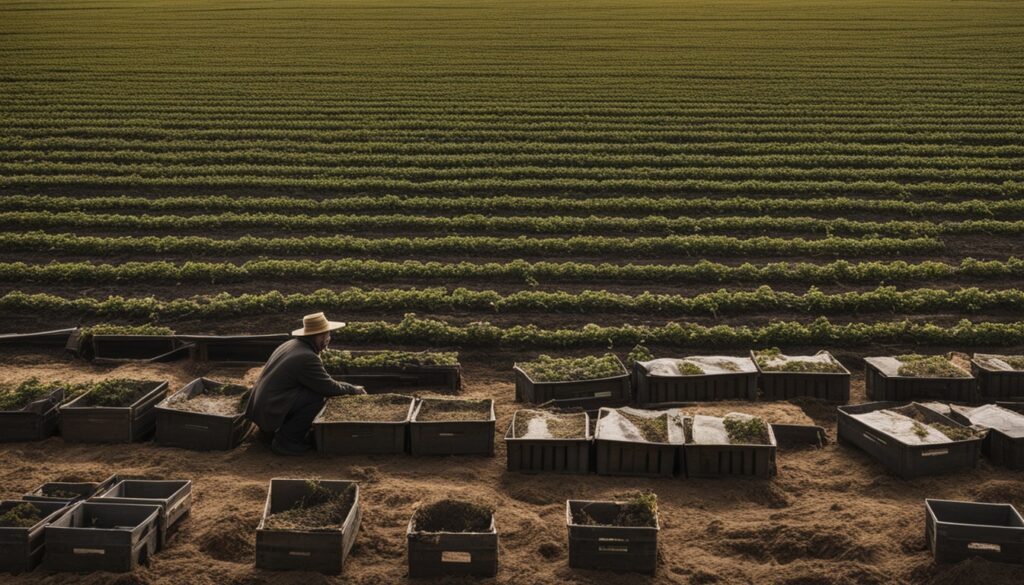
Water and Land Availability
Tomato farmers are facing tough times due to a lack of water and land. In Ethiopia, tomato production dropped from 81,738 tons in 2011 to about 55,000 tons in 2013. This decrease is linked to how water is managed and rules on farming practices.
Growing tomatoes needs the right balance of water and the right soil. Tomatoes do best in light, well-drained soils with a pH of 5 to 7. They grow deep, with roots that can go 1.5 meters down. But, getting the right amount of water, around 400 to 600 mm per season, can be hard. This is especially true in places with little water due to droughts.
Impacts of Climate Change and Environmental Regulations
Climate change and strict rules on the environment also add to the farmers’ problems. Using nitrogen fertilizers can really help tomato plants grow. The best yield, 35,903 kg per hectare, was seen when certain amounts of water and nitrogen were used together. But, these days, rules might not allow farmers to use all the fertilizers and pesticides they would like to. This affects how many tomatoes they can grow.
Climate change can cause too much water in the ground, which is bad for tomato plants. This problem can lead to diseases like bacterial wilt. The effect of not having enough water on tomato crops can be very hard. This is especially true during key growth stages like when flowers appear and when the fruits start forming.
| Metric | Value |
|---|---|
| Tomato production in Ethiopia (2011) | 81,738 tons |
| Tomato production in Ethiopia (2013) | 55,000 tons |
| Highest marketable fruit yield | 35,903 kg/ha |
| Lowest marketable fruit yield | 13,655 kg/ha |
| Highest water use efficiency | 5.4 kg/m³ |
| Lowest water use efficiency | 2.3 kg/m³ |
To fight these challenges, farmers should consider new ways to use water. They can try precision irrigation. And sustainable water use methods are important too. Also, developing tomatoes that can live with less water and using the land better can help against climate change and tough rules.
“The main challenge is power for pumps for water, packhouses, washing machines. It costs farmers an enormous amount. I have been told by a farmer that where his energy costs used to be 12 to 15%, it now runs to 48% of his production cost.”
– A tomato trader at the Johannesburg municipal market, commenting on the challenges faced by South African tomato farmers due to rising energy costs.
Trade Policies and Market Access
Tomato farmers face a tough time dealing with trade rules and limits to reach good markets. Nigeria produces a lot of tomatoes but struggles to sell them because of these barriers. There are many smallholder farmers in Nigeria who need better ways to sell their tomatoes.
Export rules set by the government are a big issue for these tomato farmers. They want to talk with leaders about making these rules clearer and fairer. Unpredictable rules make it hard for farmers to know how to grow their businesses.
This problem is not just in Nigeria. The trade of tomatoes worldwide has seen a lot of ups and downs. In 2016, over 8 million tons of tomatoes were traded, worth 8.5 billion US dollars. But, not every place benefits the same from this trade.
As an example, Mexico is the top tomato exporter, and the United States buys the most. This can raise worries about trade being fair and not hurting tomato farmers’ incomes worldwide. Brexit might make selling tomatoes uncertain, affecting trading on both sides of the Atlantic.
Leaders and tomato business people need to listen to what small farmers are saying, especially from places like Nigeria. By making markets better and clearer for everyone, these farmers can do well. This can even help their country become safer with food and bring growth.
Technological Adoption and Research Support
With a growing global population and economic challenges, the agriculture sector looks towards technology. It aims to boost productivity and stay sustainable. According to the United Nations, the world may have over 9.7 billion people by 2050. This leads to a higher need for food.
The World Bank has put $6.7 billion into agriculture and similar fields. It’s helping 1.3 million farmers use high tech in their farming. Since then, the use of new technologies has led to six times more crops in 40 years.
Digital technology in agriculture now includes AI, smart farming, and GPS, among other things. Yet, skilled workers are needed for the smart machines in farming. Studies have looked at how tech helps farmers in different ways.
For example, it affects what they make, how much they work, and how they spend their money. The results vary.
More research is needed, looking at both rich and poor countries. Plus, a mix of numbers and stories can show the real effect of tech on farmers.
Looking closer at tomatoes, we see that technology is very important for farming them. It’s a big part of Pakistan’s money, making up almost 20% of their GDP. Around the world, we make about 159 million tons of fresh tomatoes each year.
In Pakistan, tomato farming has grown a lot. From 2007-08 to 2015-16, production went up a ton. The land for growing also got bigger. On average over the last ten years, each hectare of tomato land in Pakistan makes about 10.1 tons.
Still, tomato farmers in Pakistan and other places face problems like bugs, diseases, and a lack of new technology. Recent studies say we need more tech use. We should also help farmers learn more.
Future research could look into fighting pests and diseases better.
Plus, it is important to find smart ways to use water and fertilizer and grow tomatoes that are strong against diseases.
Other studies have checked if growing tomatoes without chemicals are good for the money. They also looked at how helpful some bacteria are for growing tomatoes3.
With more people in the world and a higher need for food, tech in farming is key.
This is especially true for tomatoes. It can help make food safer and give small farmers a better life. New research is aiming to find ways to grow more food in a good way. This will help farmers and the people who eat the food.
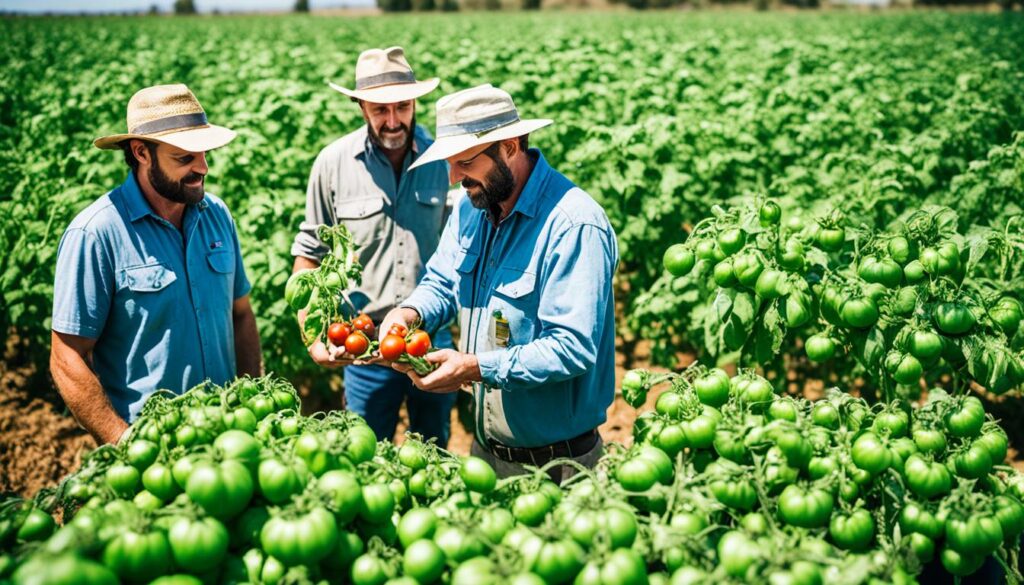
Conclusion
Tomato farming is a complex world with many challenges. Globally, growers deal with changing prices, market shifts, and high costs. Weather hits Ghanaian farmers, while pests hurt Indian crops, and Malawian growers face many hurdles.
Despite these issues, there is hope. Smart farming, better pest control, and government aid can help farmers. Plus, developing hardy crop types and better irrigation fights climate change effects. It’s key to make sure all farmers get fair government and financial aid.
With more and more people wanting tomatoes, everyone must pitch in to help farmers. This includes policymakers, researchers, and those in the industry.
By focusing on government aid, farm subsidies, and new tech, the tomato world can keep growing sustainably. This helps everyone, from farmers to consumers and the whole farming sector.
FAQ
What are the key economic challenges faced by tomato farmers?
How do price volatility and market competition affect tomato farming?
What are the main input costs and access to credit issues for tomato farmers?
What transportation and storage challenges do tomato farmers face?
How do pest and disease management costs affect tomato farming?
What other economic challenges do tomato farmers encounter?
How do water and land availability impact tomato farming?
How do trade policies and market access affect tomato farmers?
What role do technology and research play in supporting tomato farmers?
Source Links
- https://www.hortidaily.com/article/9534768/multitude-of-challenges-and-opportunities-in-tomato-market/
- https://producepay.com/blog/challenges-in-the-production-and-export-of-tomatoes-in-mexico/
- https://www.ncbi.nlm.nih.gov/pmc/articles/PMC8207062/
- https://core.ac.uk/download/pdf/234674485.pdf
- https://www.mdpi.com/2071-1050/15/21/15478
- https://www.linkedin.com/pulse/tomato-price-surge-india-consequence-farming-woes-sivaprasad-reddy
- https://afsaap.org.au/assets/Arah-Isaac-Kojo.-An-overview-of-post-harvest-challenges.pdf
- https://assets.publishing.service.gov.uk/media/57a0899ae5274a31e000018a/61280-Njenga-Willilo-Hine-IFRTD-2015-FirstMileTransportTomatoesTanzania-Final-AFCAP-Tan2015c-v160114.pdf
- https://www.ncbi.nlm.nih.gov/pmc/articles/PMC7184524/
- https://journals.ashs.org/horttech/view/journals/horttech/30/1/article-p64.xml
- https://ageconsearch.umn.edu/record/57763/files/368-5.pdf
- https://www.sciencedirect.com/science/article/abs/pii/S0261219405002267
- https://fsnetafrica.com/blog/socio-economic-impacts-of-tomato-post-harvest-losses-phl-on-women/
- https://ijhst.ut.ac.ir/article_77127.html
- https://www.nature.com/articles/s41598-024-62884-5
- https://www.fao.org/land-water/databases-and-software/crop-information/tomato/en/
- https://cals.cornell.edu/news/2023/06/bending-curve-tomato-loss-can-help-nigerian-farmers-reduce-poverty
- https://www.ncbi.nlm.nih.gov/pmc/articles/PMC8092757/
- https://edis.ifas.ufl.edu/publication/FE1027
- https://www.ncbi.nlm.nih.gov/pmc/articles/PMC10835251/
- https://researcherslinks.com/current-issues/Adoption-Constraints-of-Improved-Technologies-Regarding-Tomato-Cultivation-in-District-Mardan-KP/14/1/1517/html
- https://ecologyandsociety.org/vol27/iss3/art26/
- https://academicjournals.org/journal/AJAR/article-full-text/C01C5E768786

